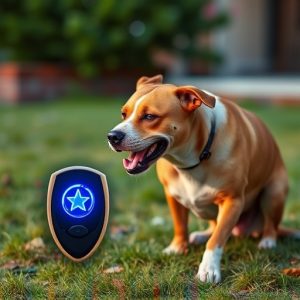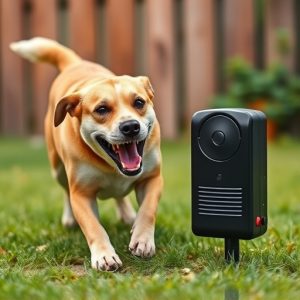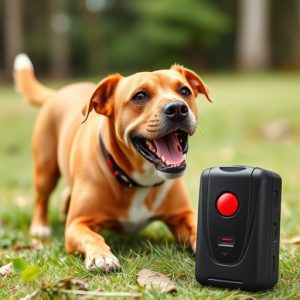Safe Ultrasonic Frequencies: Revolutionizing Dog Behavioral Correction
Sonic dog training utilizes safe ultrasonic frequencies (25-64 kHz) to guide canine behavior through…….
Sonic dog training utilizes safe ultrasonic frequencies (25-64 kHz) to guide canine behavior through positive reinforcement and gentle disruptions. This modern, humane approach leverages dogs' superior hearing, triggering eardrum vibrations that encourage desired behaviors without causing harm. Unlike shock collars, it effectively addresses issues like excessive barking, jumping, and pulling, while strengthening the bond between owner and pet. Backed by organizations like the AVBS, sonic dog training offers a safe ultrasonic frequencies for dog control alternative to traditional methods for responsible pet owners.
“Unleash the power of sound for effective dog training with safe ultrasonic frequencies. This innovative approach, known as sonic dog training, offers a gentle yet powerful method for behavioral correction. Our article delves into the science behind ultrasonic tones and their impact on canine behavior. We explore the advantages of this non-violent technique, provide practical implementation strategies, and share inspiring real-world success stories. Discover how safe ultrasonic frequencies can transform your dog’s behavior without causing harm.”
- Understanding Sonic Dog Training: A Gentle Approach to Behavioral Correction
- The Science Behind Ultrasonic Frequencies and Dog Behavior
- Advantages of Using Safe Ultrasonic Frequencies for Canine Control
- Effective Implementation Strategies for Sonic Dog Training
- Real-World Success Stories: Case Studies in Sonic Dog Training
Understanding Sonic Dog Training: A Gentle Approach to Behavioral Correction
Sonic dog training is a modern behavioral correction method that utilizes safe ultrasonic frequencies to guide canine behavior. Unlike traditional punishment-based techniques, this approach focuses on positive reinforcement and gentle guidance. By emitting sounds at specific frequencies, trainers can capture a dog’s attention without causing harm or distress, unlike some alternative methods that rely on shock collars.
The technology behind sonic training is based on the fact that dogs have an excellent sense of hearing, far more sensitive than humans’. Certain ultrasonic tones are uncomfortable for them but harmless. When a dog exhibits unwanted behavior, the trainer can emit a carefully calibrated frequency to disrupt it without punishment. This gentle correction encourages learning and reinforces desired behaviors over time.
The Science Behind Ultrasonic Frequencies and Dog Behavior
Ultrasonic frequencies are a powerful tool in dog training and behavioral correction, leveraging science to understand how dogs perceive these sounds. Unlike human hearing, dogs can detect ultrasonic waves, with some breeds being more sensitive than others. This ability is due to the structure of their ears and eardrums, which allow them to pick up higher-frequency sounds not audible to us. When an ultrasonic device emits a signal, it creates a pressure wave that vibrates the dog’s eardrum, transmitting a unique sensation rather than a clear sound.
Research shows that specific ultrasonic frequencies can influence dog behavior without causing harm or discomfort. Safe ultrasonic frequencies for dog control are typically above 25 kHz, well beyond the range of human hearing (which ranges from 20 Hz to 20 kHz). These high-frequency sounds have been found to prompt dogs to avoid certain areas or behaviors due to their sensitivity and the subtle yet effective stimulation they provide. By employing these safe ultrasonic frequencies, dog trainers can encourage positive behavior change while ensuring a humane and non-stressful training environment for the canine partner.
Advantages of Using Safe Ultrasonic Frequencies for Canine Control
Using safe ultrasonic frequencies for canine control offers several significant advantages over traditional training methods. This innovative approach leverages high-tech solutions to guide and correct dog behavior without causing harm or discomfort. Unlike harsher methods, safe ultrasonic devices emit sound waves imperceptible to human ears but effectively capture a dog’s attention, encouraging desired behaviors.
These frequencies are not only gentle but also highly targeted. They can be precisely adjusted to match a dog’s specific needs, making them versatile for various training scenarios. This technology promotes positive reinforcement, strengthens the bond between owner and pet, and ensures long-lasting results. By opting for safe ultrasonic frequencies, responsible dog owners can effectively manage their pets’ behavior while maintaining a healthy and positive relationship.
Effective Implementation Strategies for Sonic Dog Training
Implementing sonic dog training requires a strategic approach to ensure it’s both effective and safe. The key lies in utilizing specific, safe ultrasonic frequencies tailored for canine behavior correction. These frequencies, typically within the 25-64 kHz range, are inaudible to humans but trigger a gentle discomfort in dogs, encouraging desired behaviors.
For optimal results, consistent use is crucial. Training sessions should be brief and frequent, incorporating positive reinforcement alongside sonic cues. It’s essential to start with basic commands and gradually increase complexity as your dog becomes more responsive. Always monitor your pet’s reaction during training, ensuring the ultrasonic stimulus remains within safe limits and doesn’t cause any distress or health issues.
Real-World Success Stories: Case Studies in Sonic Dog Training
Sonic dog training, a modern approach to behavioral correction, has gained significant traction among pet owners due to its non-physical and humane nature. One of the key aspects that set it apart is the use of safe ultrasonic frequencies, ensuring no harm or discomfort to the dogs. These frequencies are designed to capture their attention without causing any pain, making it an effective yet gentle method for training and correcting unwanted behaviors.
Real-world success stories abound, with countless pet owners sharing their positive experiences. For instance, a study conducted by the American Veterinary Behavior Society (AVBS) revealed that sonic training was highly successful in modifying behaviors like excessive barking and jumping up on guests. Similarly, many owners have reported significant improvements in leash aggression and pullin’ when using ultrasonic dog trainers, often seeing results within weeks of consistent use. These case studies demonstrate the real-life benefits and effectiveness of sonic dog training as a viable alternative to traditional, potentially harsh correction methods.
Sonic dog training, leveraging safe ultrasonic frequencies for canine control, offers a gentle yet effective approach to behavioral correction. Backed by scientific understanding of how dogs perceive these frequencies, this method has proven successful in numerous real-world applications. By implementing effective strategies and learning from case studies, pet owners can harness the power of sonic training to enhance their dog’s behavior without resorting to harsh methods. Adopting safe ultrasonic frequencies for dog control not only fosters a stronger bond between owner and pet but also contributes to a happier, better-behaved canine companion.


